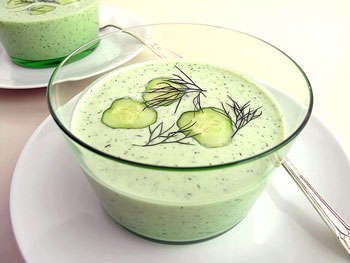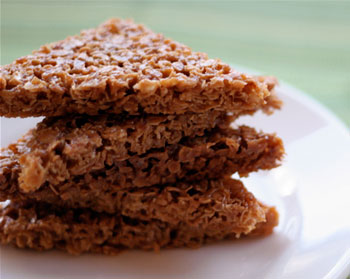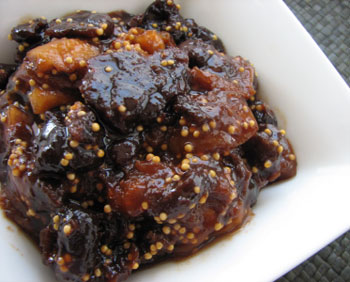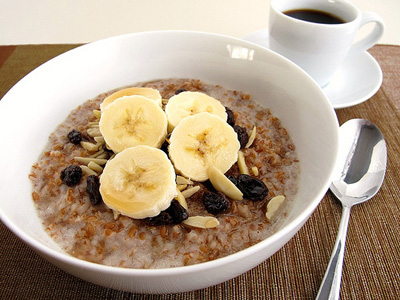 When it's incredibly hot outside, like it has been this month,
standing by a hot stove is not something anyone wants to do. Grilling
outside is another option, but when it's too hot to even do that, what
do you do? Why not make a no-cook recipe, like a chilled soup? The
cooling qualities of a cold soup are perfect on days where you need a
refreshing respite from the sweltering heat. And there's no better way
to achieve that than with a cold soup.
When it's incredibly hot outside, like it has been this month,
standing by a hot stove is not something anyone wants to do. Grilling
outside is another option, but when it's too hot to even do that, what
do you do? Why not make a no-cook recipe, like a chilled soup? The
cooling qualities of a cold soup are perfect on days where you need a
refreshing respite from the sweltering heat. And there's no better way
to achieve that than with a cold soup.
The tradition of cold, raw soups comes by way of Spain and their famous
gazpachos. Originally, the recipe was made with just bread, garlic, and
oil (bread and oil were the thickeners and garlic helped cool the body
by way of sweating.) After the New World explorations, tomatoes were
added to the recipe, creating what we know of today as the classic
gazpacho. Many other nations have cold soups too, just think of borscht.
In Hungary cucumber soup is very popular during summer. The pairing of
cucumbers and yogurt is one that can be found in Mediterranean, Middle
Eastern, and Indian cuisines. This recipe takes inspiration from all of
these.
Retro Recipes and Traditional Fare
Retro Recipes and Traditional Fare
Chocolate Cinnamon Rolls Save a Cookbook
 I'm still rolling through my office, trying to organize every inch of it, with the help of my friend, the professional organizer. We're making great progress. Tops of my desks have stayed mostly clear. My files are filling up. I'm finally seeing blank space on the shelves in my storage closet, the result of some purging.
I'm still rolling through my office, trying to organize every inch of it, with the help of my friend, the professional organizer. We're making great progress. Tops of my desks have stayed mostly clear. My files are filling up. I'm finally seeing blank space on the shelves in my storage closet, the result of some purging.
There is much more to do before the job is done. My organizer strongly suggests I get my cookbook collection all in one place and that place should be my office. Cookbooks live on shelves in the storage closet in my office, on shelves and in a bookcase in an extra bedroom, in a pile next to my bed and a few on the ottoman in the living room. I shudder when I think of consolidating this enormous number of books into one space in my office. I fear the "organizer" will tell me to start choosing cookbooks to put in a "give-away box."
Flapjacks: The British Madeline
 When I was growing up in England in the fifties and sixties, there was a snack called a flapjack that could be occasionally bought at bakeries but was more often found in homes, served up by diligent housewives. It was never found at my home: the only time my mother turned on the stove was to light a cigarette. But some of my friends’ mothers did make them, and the sweet, buttery smell of freshly baked flapjacks is one of those childhood aromas that still haunt me today.
When I was growing up in England in the fifties and sixties, there was a snack called a flapjack that could be occasionally bought at bakeries but was more often found in homes, served up by diligent housewives. It was never found at my home: the only time my mother turned on the stove was to light a cigarette. But some of my friends’ mothers did make them, and the sweet, buttery smell of freshly baked flapjacks is one of those childhood aromas that still haunt me today.
Now, for the American reader a point of clarification is required. British flapjacks bear absolutely no resemblance to American ‘flapjacks’, which seems to be just another word for pancakes. The British flapjack is a unique item unto itself, but if a comparison is required, I suppose a granola bar would come closest in look and texture. But it is simpler, more elemental, only requiring four ingredients (long before Michael Pollan came up with his five ingredient mantra): oats, sugar, butter and golden syrup.
How to Make Mostarda
 I spent a year living in Europe, and six months of that was in Italy. Having eaten a lot of Italian food, I like to think I understand it, perhaps just a little. In fact, whenever I try to recreate an Italian dish I think back to earlier versions that I've eaten. What was it that I liked about it? What was the essence of the dish?
I spent a year living in Europe, and six months of that was in Italy. Having eaten a lot of Italian food, I like to think I understand it, perhaps just a little. In fact, whenever I try to recreate an Italian dish I think back to earlier versions that I've eaten. What was it that I liked about it? What was the essence of the dish?
In all my time in Italy, I don't remember trying mostarda. It's not surprising really because the most well-known versions come from Veneto, Lombardia and Piemonte. Most of my time was spent in Tuscany. But I still think I understand mostarda, just a bit. It's like an Italian chutney I suppose. Don't make the mistake of translating it as "mustard". Mostarda does have a little bit of mustard in it, but it's really a combination of preserved fruit in syrup with a bit of a kick. The kick comes from mustard oil, mustard essence, dry mustard, mustard seeds or some combination thereof. Other ingredients include sugar or honey, wine, vinegar and sometimes citrus juice.
When I am developing a recipe, I often look for several variations then strike off on my own. The recipes I found for mostarda varied greatly--some used dry fruit, others fresh fruit. Some cooked slowly others cooked quickly. Some had lots of mustard, others barely a pinch. My own experiment lead me to this conclusion: Mostarda is very forgiving and can easily be made to your own taste. You can taste as you go and make changes.
Bulgur Breakfast Cereal with Dried Fruit and Nuts
 It's that time of year again when everyone is ready to jump onto the get-fit wagon. I could easily say that I should include myself in that group, but I believe it's best to start by taking small steps before diving into a plan that you might not keep up. My first step for the New Year is a healthy one, it's simply to eat more healthy foods, like whole grains and to limit my intake of sugar. I actually love whole grains, but I just don't eat them often enough. Luckily my only downfall sugar-wise is chocolate, so it's easy for me to exclude sweets and candies entirely. But I've recently found myself using agave syrup as my choice of sweetener. That was my first step, what's yours?
It's that time of year again when everyone is ready to jump onto the get-fit wagon. I could easily say that I should include myself in that group, but I believe it's best to start by taking small steps before diving into a plan that you might not keep up. My first step for the New Year is a healthy one, it's simply to eat more healthy foods, like whole grains and to limit my intake of sugar. I actually love whole grains, but I just don't eat them often enough. Luckily my only downfall sugar-wise is chocolate, so it's easy for me to exclude sweets and candies entirely. But I've recently found myself using agave syrup as my choice of sweetener. That was my first step, what's yours?
Eating whole grains doesn't just mean switching your morning toast from white to wheat. It means eating actual whole grains preferably in their minimally processed forms. In place of white rice try brown. Eat steel-cut oats rather than instant. Try some different whole grains, like amaranth, millet, buckwheat, barley, or bulgur. Bulgur is one of my favorites. If you've ever had Middle Eastern or Turkish food, you've probably already eaten bulgur without knowing. The salad tabbouleh and the meatballs called kofta or kefteh are made with bulgur. It's not an unrecognizable grain, bulgur is actually wheat.
More Articles ...
Welcome to the new One for the Table ...
Our Home Page will be different each time you arrive.
We're sure you'll find something to pique your interest...
